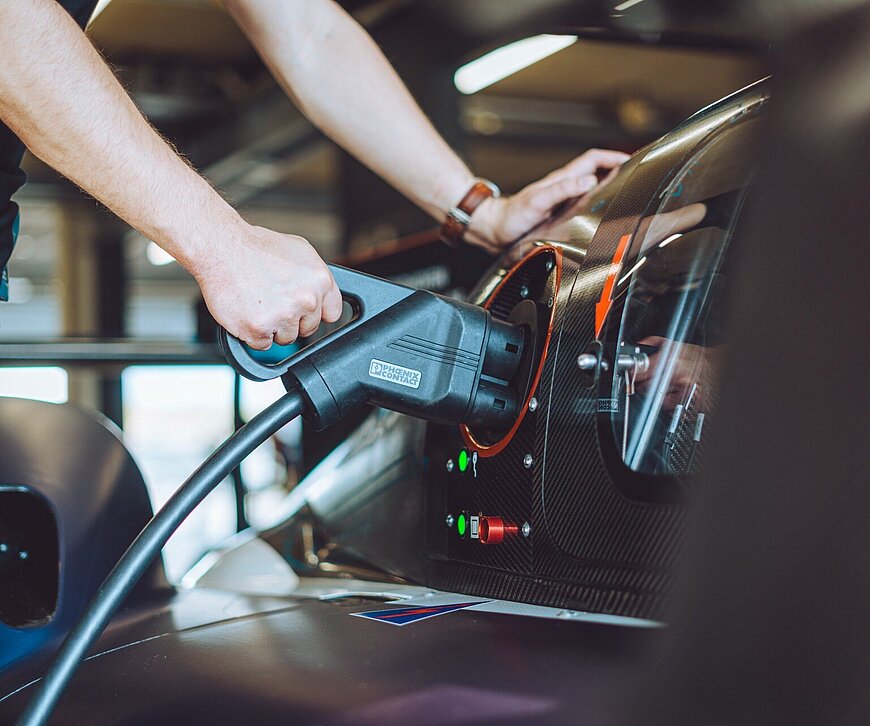Charging as fast as refueling? That is certainly possible!

Charging as fast as refueling? That is certainly possible!
The future of mobility is a contemporary 'hot topic'. From 2035, new cars with a combustion engine will no longer be sold. People have slowly started to switch to electric driving, but there are clearly still some obstacles that need to be overcome to get everyone to adopt the idea.
InMotion is a student team from Eindhoven University of Technology that is committed to tackling the problems in electric mobility. They are developing the world's fastest charging electric endurance racing car. They want to accelerate the energy transition in the automotive industry. In this first of three articles we discuss the challenges that arise in electric driving, and the development of its technology.
Challenges of Electric Driving
Although the students of InMotion are fully convinced of the future of electric mobility, there are still many Dutch people who (have to) stay behind. Electric cars are expensive, have little range, and take a long time to recharge. As a pioneer in the sector, InMotion tries to tackle these challenges. At the moment they are mainly focusing on the latter: the loading time.
Electric drivers who have the option to charge at home and/or at work are less likely to complain; After all, their car can almost always charge when it is not moving. However, there is a number of people that do not have the option to do this. Consider, for example, residents of densely populated cities, where not everyone has room for a driveway with a charging station. Those users then have to rely on public charging en route.
That's why you're probably familiar with 'fast charging'. The term implies that you can quickly continue your journey. But, that's really disappointing. 'Fast charging' is now around twenty minutes under optimal conditions - with the latest models. And then of course the charging station must also be free. While you can get through the gas station within 10 minutes with 2 cars in front of you, the electric version will take you at least an hour. From that perspective, electric cars are a lot less user-friendly than the conventional petrol model.

Electric Refueling
That can and should be done differently, InMotion believes. The solution? Electric Refueling. The name gives it away a bit, but it is quite simple: charge in the same time as you can refuel. In the Next Generation BatteryPack (NGBP) – completely designed by the students themselves – the implementation of cell-level cooling makes it possible to charge in less than 4 minutes! This would allow a normal passenger car to drive approximately 250 km.
The biggest challenge with fast charging is heat. Too much heat is bad for your battery and can even cause dangerous situations in the most extreme cases. As mentioned earlier, InMotion has tackled this challenge with cell-level cooling. This means that each battery cell – of which there are hundreds in the package – is cooled individually. This significantly increases the contact surface between the warm cells and the cooling. This way, each cell is individually kept at the optimal temperature and there are therefore no temperature differences throughout the package.
To illustrate, you can compare this form of cooling with a cool box filled with cans of cola. Instead of placing a cooling element under and above the cans, the entire box is filled with small ice cubes so that more cold pieces of ice touch the cans and therefore cool them down faster.
InMotion implements this battery pack in an LMP3 endurance racing car. Unlike Formula-E, for example, endurance racing cars are designed for endurance so that they can maintain top speed for several hours or days. InMotion chose this to test the technology in the toughest conditions. Super-fast charging is also useful in the racing world; After all, it's all about one thing: speed. This also applies to electric racing. Whoever can load the fastest loses the least time.

InMotion as a student team
What is unique about InMotion is that the team works on a continuous project. Although a new team is installed every year, they continue where the old team left off. This means that the same thing does not have to be done every year, which means optimal innovation can take place.
To reflect on this year's progress and challenges, InMotion will hold an event next Friday, August 16, to close out this academic year. The current team will look back on all the challenges they encountered this year and how they dealt with them. You can read what the biggest challenges were in the next article on August 23. Here we will also zoom in deeper into what it is like to innovate in the technological sector, as well as discuss future plans.
